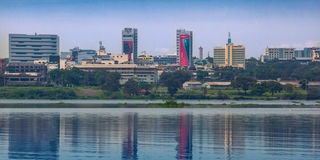21 years later, Kisumu City to get its first traffic lights

Kisumu skyline as seen from Lake Victoria.
Traffic lights will be installed in Kisumu city in November as part of a three-part strategy to ease traffic flow in peak hours.
The lights will go up at three main junctions – the Kisumu Boys High School, Patel’s and Kondele roundabouts.
This will happen 21 years after Kisumu was declared a city by former President Daniel Arap Moi.
Major cities and towns, such Nairobi, Mombasa and Eldoret, have traffic lights but not Kisumu.
Kisumu City Manager Abala Wanga said CCTV cameras and Wi-Fi will be installed in the city and surveillance will be boosted.
"I met the consultant and the resident engineer of the project to discuss this initiative which will be a boost in our smart city objective as we plan to install CCTVs and Wi-Fi in the main streets in the city and the informal settlements," Mr Wanga said.
Four lane highway
Traffic lights became necessary when work on the four-lane Kisumu-Nairobi highway and the Kisumu-Kakamega road started. They are expected to improve pedestrian safety and traffic flow.
However, completion of the Kisumu-Kakamega may take longer as the Kenya National Highways Authority has suspended the work because of financial constraints.
Construction of the dual carriageway is at 96.4 percent complete.
As the traffic lights are installed, schools and the public will be educated on what officials hope to achieve, while transport stakeholders will be urged to ensure the roads and lights are used as intended.
The annual average death toll on Kenyan roads, now at 3,000, was exceeded last year, when more than 4,000 people died.
The National Transport and Safety Authority (NTSA) says 3,358 people perished on roads between January 1 and September 13.
Some 1,208 of these were pedestrians. Human error, reckless driving and speeding are mostly to blame.





